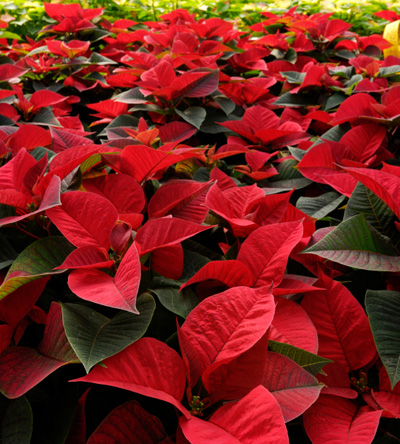According to the University of Illinois Extension, $220-million worth of poinsettias are sold during the holiday season. The preferred color? For 74 percent of Americans, the answer is red; 8 percent prefer white; and 6 percent choose pink.
But what most people think of as the flowers are actually colored bracts or leaves, which surround a small, yellowish-green structure that is the true flower.
Today’s poinsettia is much improved from the poinsettia of years ago, thanks to plant breeders. Although red is still the most popular color, pink-, salmon- and white-colored bracts are also available. Even speckled pink, red and white bracts are now available in cultivars, such as Jingle Bells and Monet. Even more recent on the scene are those with variegated green and yellow leaves, bracts that have sharply pointed lobes that resemble holly leaves and a few that have ruffled bracts.
New cultivars tend to have a greater number of large flowers on more compact plants. Poinsettia trees are also popular as are hanging baskets. Like many other florists’ plants, dwarf poinsettias can be found that pack a lot of color in a small package.
Extend the Beauty
The long-lasting nature of today’s poinsettias can only be enjoyed if they receive the proper care in your home. The best way to extend their beauty is to match, as closely as possible, the conditions in which they were produced. Poinsettias are raised in greenhouses where cool temperatures can be maintained between 60 F and 75 F with high relative humidity and high light intensity.
These conditions will be difficult if not impossible to match in the home. Natural light intensity tends to be quite low and of shorter duration in the winter. And as we heat the air indoors, the air becomes drier so that relative humidity often drops below the level of plant and people comfort.
Make the most of the situation by placing your plant near a sunny window, but do not allow the foliage or flowers to contact cold window glass. Artificial light may be needed to extend growing periods. A humidifier will increase both plant and people comfort. Grouping plants together on a pebble tray will help raise humidity around the plants themselves. Both hot and cold drafts can cause leaf drop, so avoid placing plants near doors or heating vents.
Both under- and overwatering can decrease the life of your plant. Plants that are allowed to wilt will begin to brown along the edges of the leaves or may drop leaves entirely. Watering too often will prevent proper aeration of the soil, and roots will begin to die and decay. Poinsettias should be watered when the top inch of soil feels dry to the touch. If your pot was wrapped in foil, be sure to poke a few holes through the bottom to allow water to drain away.
And if you’re giving a poinsettia as a gift, be sure to protect it from frigid outdoor temperatures during transport. If you make your purchase from a florist or other supplier, be sure they wrap your purchase. Get the plant from the store to your car as quickly as possible. Preheat the car beforehand to prevent further chilling injury. Plants left in an unheated car can be injured or killed quickly, so drop the plants off at home before running other errands.
Poisonous Plant?
The poinsettia is often listed as a poisonous plant; however, there is no scientific evidence to support this conclusion. Even in studies where rats were fed poinsettias, the rats showed no evidence of poisoning. Some people are sensitive to the milky sap in the plant and may develop a skin irritation if they are in contact with that sap. It is always best to keep plants out of the reach of children and pets.
For more information, visit urbanext.illinois.edu/poinsettia/index.cfm.
B. Rosie Lerner is an extension consumer horticulture specialist at Purdue University.
Become a Saturday Evening Post member and enjoy unlimited access. Subscribe now



